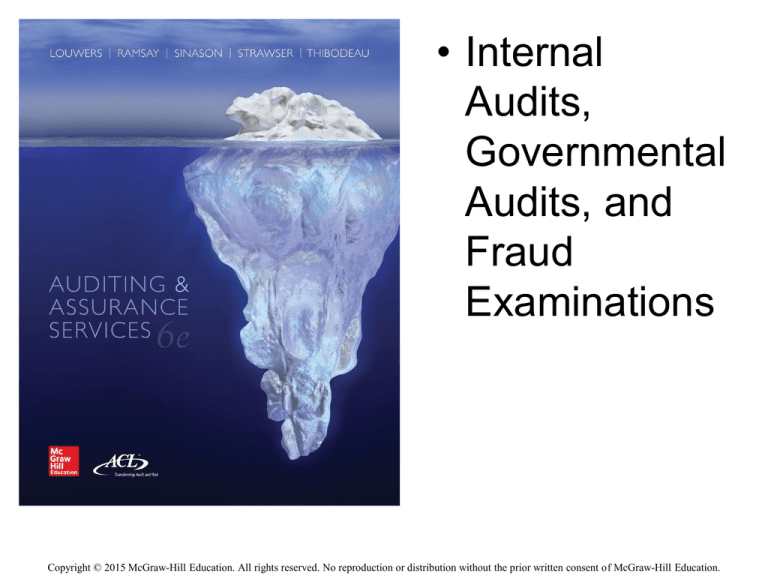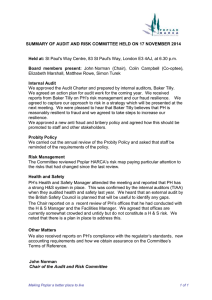
• Internal
Audits,
Governmental
Audits, and
Fraud
Examinations
Copyright © 2015 McGraw-Hill Education. All rights reserved. No reproduction or distribution without the prior written consent of McGraw-Hill Education.
Module D
Internal Audit, Governmental Audit,
and Fraud Examination
“You have a chance to really learn and improve the business. You build
relationships with the board and major business leaders. You can move
internal audit to more value-added processes. And it builds your ability to
manage people and work with cross-functional teams.
- Michael Fung, CFO Wal-Mart North America,
on his years spent in internal audit
Mod D-2
Module Objectives
1.
2.
3.
Define internal auditing; describe internal audit institutions
(e.g. IIA); describe how internal auditors interact with
independent auditors; explain internal auditors’
independence problems; and list features of internal
reports.
Define governmental auditing; describe governmental audit
institutions (e.g. GAO); describe how governmental
auditors interact with independent auditors; explain
governmental auditors’ independence problems; and list
features of governmental audit reports.
Explain the function of standards and measurements in
economy, efficiency and program audits.
Mod D-3
Module Objectives
4.
5.
6.
7.
Describe the Single Audit Act of 1984 in relation to
audits of governmental fund recipients.
Define fraud examination; describe various
engagements performed by fraud examiners.
Describe the elements necessary for a successful fraud
examination and explain the differences between how
fraud examination and external auditors handle
evidence.
Describe the ways CPAs can assist in prosecuting fraud
perpetrators.
Mod D-4
INTERNAL AUDITING DEFINED
• Independent and objective
• Assurance and consulting activity
• Adds value and improves an organization’s
operations.
• It helps an organization accomplish its objectives
• A systematic, disciplined approach to evaluate and
improve the effectiveness of
– risk management,
– control, and
– the governance process.
Mod D-5
Internal Audit vs. External
Audit
BasicallyExternal auditors audit
financial statements
Internal Auditors audit
business systems
Mod D-6
Internal Audit
Key elements to successful internal audits:
• Value Added
• Proactive – look for future problems and opportunities
• Creative – find new ways to do things
• Customer-focused
Talk to departments and managers about their issues
• Utilizes all business perspectives
understand the business
• Understand the management process.
Where are decisions made
Mod D-7
Role of the Internal Auditor
•
•
•
•
•
•
•
•
Ensure reliability and integrity of information
Safeguard assets
Ensure compliance with policies and regulations
Foster the achievement of organizational objectives
and goals
Improve operational economy and efficiency
Identify areas of business risk
Help prevent and detect fraud
Coordinate audit activities with external auditors
Mod D-8
Standards for the Professional Practice of
Internal Audit
• Attribute Standards
–
–
–
–
1000 Purpose, Authority, and Responsibility
1100 Independence and Objectivity
1200 Due Professional Care
1300 Quality Assurance and Improvement Program
• Performance Standards
–
–
–
–
–
–
–
2000 Managing the Internal Audit Activity
2100 Nature of Work
2200 Engagement Planning
2300 Performing the Engagement
2400 Communicating Results
2500 Monitoring Progress
2600 Management’s Acceptance of Risk
Mod D-9
Principles of the
IIA Code of Ethics
Integrity
establishes trust that is the basis for reliance on auditor’s judgment.
Objectivity- highest level of professional objectivity in
gathering, evaluating, and communicating information
balanced assessment of all the relevant circumstances
not unduly influenced by self interests or by others
Confidentiality
respect the value and ownership of information
Competency
apply the knowledge, skills and experience needed in the performance of
internal auditing services.
Mod D-10
Audit Applications
Financial Audits
Examine and evaluate
• Areas of management concern (e.g. new
payment process)
• Financial information used by internal
decision makers (e.g. monthly sales reports)
• Financial information being sent to outside
agencies (e.g. regulatory agencies)
Mod D-11
Audit Applications
Operational Audits
Term is sometimes used synonymously with
internal audit.
Examine and evaluate
• Current risks that need to be managed
• Possible future risks
• Internal control
• Quality, effectiveness and efficiency of performance
Mod D-12
Audit Applications
Compliance Audits
The degree the organization conforms to specific
requirements
• Policy and procedures
• Professional standards
• Laws, regulations or contracts
The audit focuses on the detailed testing of existing
conditions and compares them to requirements.
Mod D-13
Audit Applications
Corporate Governance
The board of directors and senior management must
have reliable and relevant information to meet their
responsibilities
• Management policies are in effect
• Strategy decisions are made with the best information
• Adequate progress toward goals
• Operating performance is measured and
communicated
• Risk assessment is performed and communicated
• Effectiveness of proactive risk management.
Mod D-14
Audit Applications
Performance Auditing
Evaluating
1) the efficient and effective use of recourses;
2) progress towards goals or objectives; and/or
3) results of a program are acceptable
– Identification of performance criteria is critical and may
be difficult
Mod D-15
Audit Applications
Sustainability Audits
• Corporate social responsibility
• Auditors may assist
Governance
Ethics
Environmental issues
Health, safety and security
Human rights and work conditions
Mod D-16
Audit Applications
Sustainability Audits
• Auditors may assist management in
Establishing a sustainability program
Establishing measurement criteria
Establishing reporting processes
monitoring the sustainability reporting process
Mod D-17
Audit Approach
• Risk-based auditing (RBA)
– Placing audit resources where the greatest risks exist
• Fieldwork in internal (and governmental) audits
–
–
–
–
Problem identification
Measurement criteria
Evidence collection
Evidence evaluation
• Emphasis on management and mitigation of
business risk
Mod D-18
Audit Findings
• Include both favorable or unfavorable findings
• Unfavorable findings should include
– Condition – what was found
– Criteria – basis for determining that the condition was
improper
– Cause – why did this happen?
– Effect – why is this bad?
– Recommendation – what do you think should be done
about this?
Mod D-19
Government Auditing Standards
(The Yellow Book)
Audits must be performed in accordance with
GAAS and Generally Accepted Government
Auditing Standards (GAGAS)
• As in a GAAS audit, a report on the fairness of the entity's
financial statements is issued.
• In a GAGAS audit, a report on the entity's compliance with
laws and regulations is also issued
• Illegal acts/ fraud
– Should be reported to the client unless they are clearly
inconsequential.
– May need to be reported directly to external parties.
Mod D-20
Government Auditing Standards
(The Yellow Book)
In addition to the audit of the entity's financial
statements, an examination of a governmental
entity introduces the following considerations
for the auditor's consideration:
– Compliance with Laws and Regulation
– Effectiveness of the Entity’s Internal Control
– Compliance with the Specific Requirements of Individual
Federal Financial Assistance Programs
– Compliance with Requirements Applicable to All Federal
Financial Assistance Programs
Mod D-21
Governmental Reporting
• Usually three reports
– Report on the financial statements
– Report on the auditee’s internal control
– Report on auditee’s compliance with
applicable laws and regulations
• More reports required under Single
Audit Act
Mod D-22
Single Audit Act Audit
• Required for entities who receive specified levels of
financial assistance from the federal government.
• Requires the auditor to issue the same reports as
those issued in a Government Auditing Standards
audit:
– Opinion on financial statements
– Compliance with laws and regulations
– The auditor issues an opinion on Compliance with the
Specific Requirements of nonmajor programs
– Auditor's report on Compliance with the General
Requirements
Mod D-23
Fraud Examinations
Who performs a fraud examinations (sometimes
called a fraud audit)?
• Internal audit
• Independent auditors
• Security
• Certified Fraud Examiners
• Combination working as a team
Mod D-24
Fraud Audits
• To a fraud examiner fraud is always material
– It grows
– Indicates control weaknesses
– Indicates a lack of integrity by the perpetrator
• The objective is to uncover fraud when individuals
bring forth evidence that indicates that a fraud
might exist.
–
–
–
–
Is fraud present?
What is the scope of the fraud?
Who are the perpetrators?
What control weakness allowed this to occur?
Mod D-25
Differences Between
Audits and Fraud examinations
1.
2.
Audits
Audit program
Procedural approach
1.
2.
3. Look for misstatements
4. Assess controls related
to FS
5. Material misstatements
6. Accounting Theory
3.
4.
7.
7.
Evidence documented in
audit documentation
5.
6.
Fraud Audits
No set program
Procedures defined during
investigation
Look for patterns
Evaluate how controls may
be circumvented
Fraud is always material
Theories of psychology and
human behavior
Safeguarding assets,
recovering assets, and chain
of custody for evidence
Mod D-26








